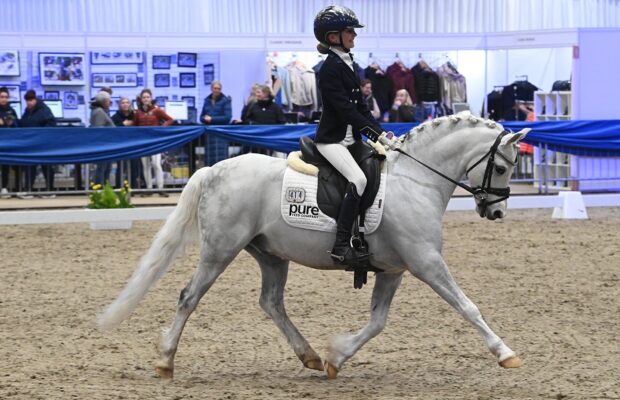At the 2023 Dressage at Devon (September 28) in the USA, Danish Olympian Cathrine Laudrup-Dufour hosted a masterclass in which she shared her top dressage training tips.
Cathrine worked with a range of horses and riders, across different levels, and we’ve rounded up five exercises you can try below.
Top dressage training tips: improving the weaker canter lead
Cathrine started the evening working with Hope Beerling on the then-six-year-old gelding Marokko, focussing on improving his weaker side in canter.
“On the right, his inside front leg really comes off the ground,” explains Cathrine, “which is nice because for the horse to tuck under, and get the back to lower itself, then you need to open up in front, so that the horse feels that he can put the hindlegs somewhere.”
Marokko was a little lower on the inside front leg on the left leg so Cathrine asked Hope to touch with her schooling whip a little bit in front of the saddle: “when his front leg is in the ground and he’s about to lift it gently tap him on the shoulder.”
“It’s not that you want a huge reaction for several steps, you just want a reaction and for the inside shoulder to come up.
“Every time they do something which is maybe not perfect, but a little bit better than before, then reward them – the more we reward the horses, the more we’re going to get back.
“All horses have one rein that is worse than the other, and this is a good way to develop the canter on the weaker rein.”
Marokko picks Hope’s use of the whip quickly, but Cathrine demonstrates how she would introduce the exercise to a less experienced horse.
She starts by asking Hope to stand on the track along the long side while she takes the whip and very gently touches the inside foreleg, asking Marokko to lift it. When he lifts, Hope rewards him and then allows him to walk on.
“I’m not using the whip in a hard way, I’m just touching him to make him aware of that part of his body. Often people use the whip as an aid to push the horse forward but for me it’s a tool to touch a specific body piece, like the shoulder or the hocks.
“I don’t like to use the whip too much on the bum, because how are you ever going to replicate that with the leg?
“I prefer to keep the whip close to my boot because then I can recreate that aid from my leg and not the whip with time.”
Introducing working canter pirouettes
Cathrine starts by asking Hope to ride large in counter canter. “I want her to keep his neck straight and connect with the outside rein and use the inside leg to adjust the tempo and the rib cage,” Cathrine explains
Every now and then she calls for Hope to give Marokko a pat – “just to make sure she’s not holding him, and to let him know there’s space for him.”
When Cathrine feels Marokko has a good balance, she asks Hope to turn a little bit in from the track towards the middle of the school – but while still imagining she has the fence on the outside.
Towards the centre of the school, Cathrine then asks Hope to collect using her outside leg and turn in a small circle and head back towards the track on the other rein.
“I know the classical way to ride the pirouette is with the inside leg and outside rein, but I find it super hard sometimes when you can’t really use your outside leg because then the horse just flies around to one side,” says Cathrine.
“The reason why I use the track is to be able to use my outside leg, without the horse wobbling to one side.”
Top dressage training tips: changing how you hold the double bridle
With Lauren Sammis and the then eight-year-old mare Heiline’s Oh Land, Cathrine started by asking her to hold the double bridle differently.
“I’m a simple copycat because this is something I’ve learnt from my trainer Kyra Kyrklund,” explains Cathrine.
Lauren holds the bridoon on top of the hand, with the rein entering her fist between the index finger and thumb, and the curb rein beneath the pinkie finger, leaving four fingers between the two reins.
“It’s a nightmare when you go from having your reins in one specific way and then you swap it,” Cathrine sympathetically adds. “But the reason why I do it is because many of us can’t have lessons every day, and because of that we do a lot of the things with the reins on autopilot. Then when you do change something, for example, the way you hold the reins, it makes you aware of which rein you’re pulling and why you’re doing that.
“This way it’s almost like holding a handle. If a horse tends to fall a little bit on the forehand, then I prefer to be clear on the bridoon, and just leave the curb there, until I feel that they come up when I ask with the bridoon. If the horse comes too high then you will feel it because the curb gets tight, which is your sign to touch the curb a little bit. It allows you to be really clear with your hands.”
Introducing the piaffe and passage
Cathrine explains that in the early stages of piaffe training, she likes to go onto a small circle, turning around the forehand and thinking about getting the horse in front of her leg.
“It’s not even about the piaffe yet, or making it fancy, it’s just about getting a reaction from the inside leg,” she adds. “I prefer the horse to be a little bit bent to the outside so I can get the front legs closer to the centre of the circle.”
Taking Lauren through the exercise, Cathrine asks her for a little impulsion from the inside leg: “This is not a piaffe, but we’re looking for her to get a little bit more light-footed, which is all we want in the beginning.”
Fast-forwarding to the next step, Cathrine details how to keep the impulsion in the piaffe past the initial five or six steps.
“Instead of punishing the horse or doing something really sharp in the piaffe when they lose energy, go back to that reaction of just moving the horse away from the inside leg, and then into some smaller steps again.
“In that way, it’s a positive correction, rather than just wanting more. You don’t want to interfere or give the horse a bad experience in the piaffe – you want it to be fun for them.”
On introducing the passage, Cathrine asks Lauren to start in a rising trot, to avoid being too heavy in the seat, and to keep the whip close to her spur.
She asks for a little at a time, compressing the energy into some passage steps before riding out in a more forward trot – “to make her a little bit electric for the transition to the passage.”
“Again instead of doing too many corrections in the piaffe and passage – which should be fun – I just go back into the trot, give them a break, refresh and get some energy back.”
“I don’t want the rider to do too much with the whip either, it’s more like playing with the way you approach it with the leg.”
Relaxing a tense horse
With eventing star Boyd Martin and Commando 3, Cathrine works through how to relax a tense, fit horse in a new environment.
“These eventing horses come in on a different level of energy, so sometimes it can be quite hard to relax the horse in a ring like this,” says Cathrine. “What I prefer to do with a tense horse is to think about the neck, if the neck goes up, you feel like the adrenaline is pumping.”
Cathrine asks Boyd to allow the neck to drop and ride some short walk to halt transitions around the outside of the arena.
“This outline is of course not perfect for a show, and I know it’s always a bit risky showing a not-so-perfect outline, but it’s the real deal, we have to put the horses round to build up back musculature and to make them stronger – it’s way too hard for them to stand in the perfect position all the time.”
Cathrine then asks Boyd to ride some simple, walk-trot transitions, almost “lazily”.
“It’s harder than it looks, transitions,” Cathrine adds, “you want to start in a new ring with transitions, something simple to build up the confidence of the horse.”
“It’s a simple thing, but sometimes I feel with the hot horses that you end up going up, down, up, down really quickly. Go slower up and down, so he listens to you and you’re not just following his quick rhythm.
“If I have a horse that continues to go quicker and quicker and doesn’t really listen to transitions or me slowing my rise then I go on a circle and stand up for two steps and then sit for one.
“It’s really awkward but it makes the horse aware of what you’re doing and gets their focus back on the rider.”
You may also be interested in…

8 training gems from Carl Hester that could transform your dressage scores

Laura Tomlinson’s top 5 novice dressage training tips that suit all types of horse

Master advanced movements with top tips from Gareth Hughes and Richard Davison

Subscribe to Horse & Hound magazine today – and enjoy unlimited website access all year round
Horse & Hound magazine, out every Thursday, is packed with all the latest news and reports, as well as interviews, specials, nostalgia, vet and training advice. Find how you can enjoy the magazine delivered to your door every week, plus options to upgrade your subscription to access our online service that brings you breaking news and reports as well as other benefits.






